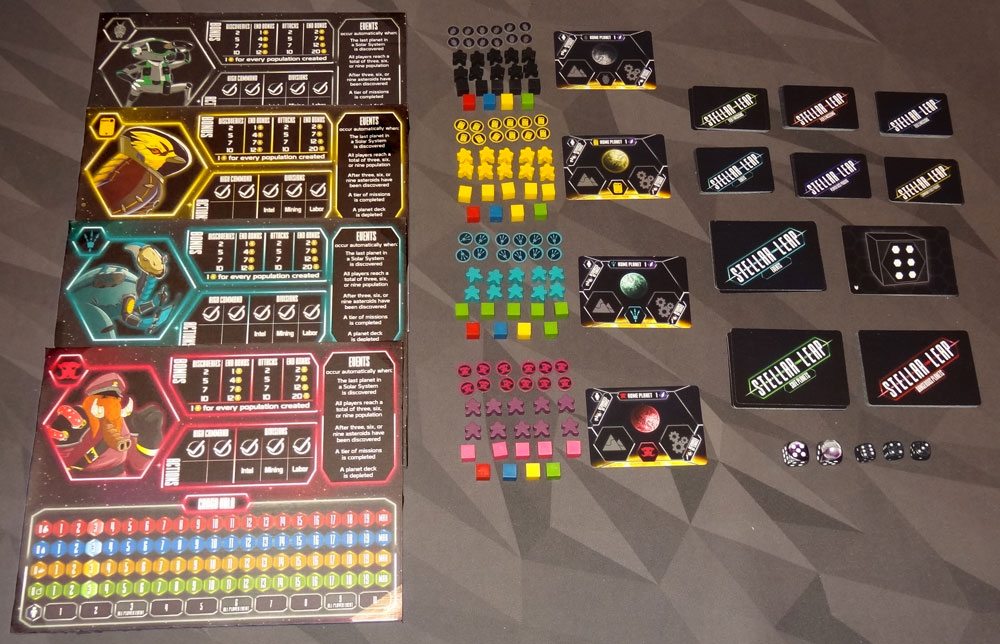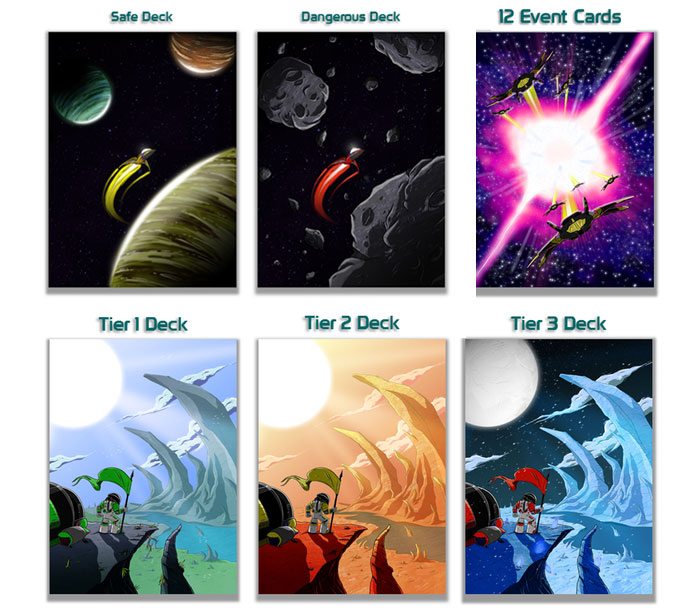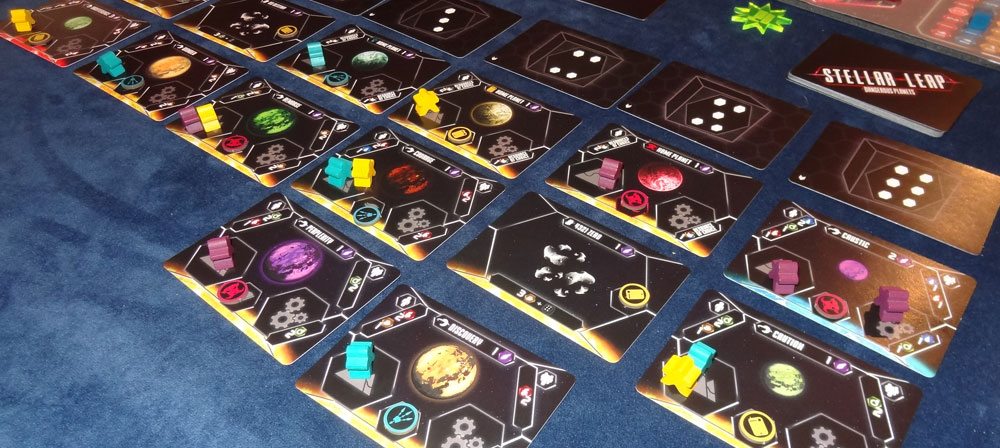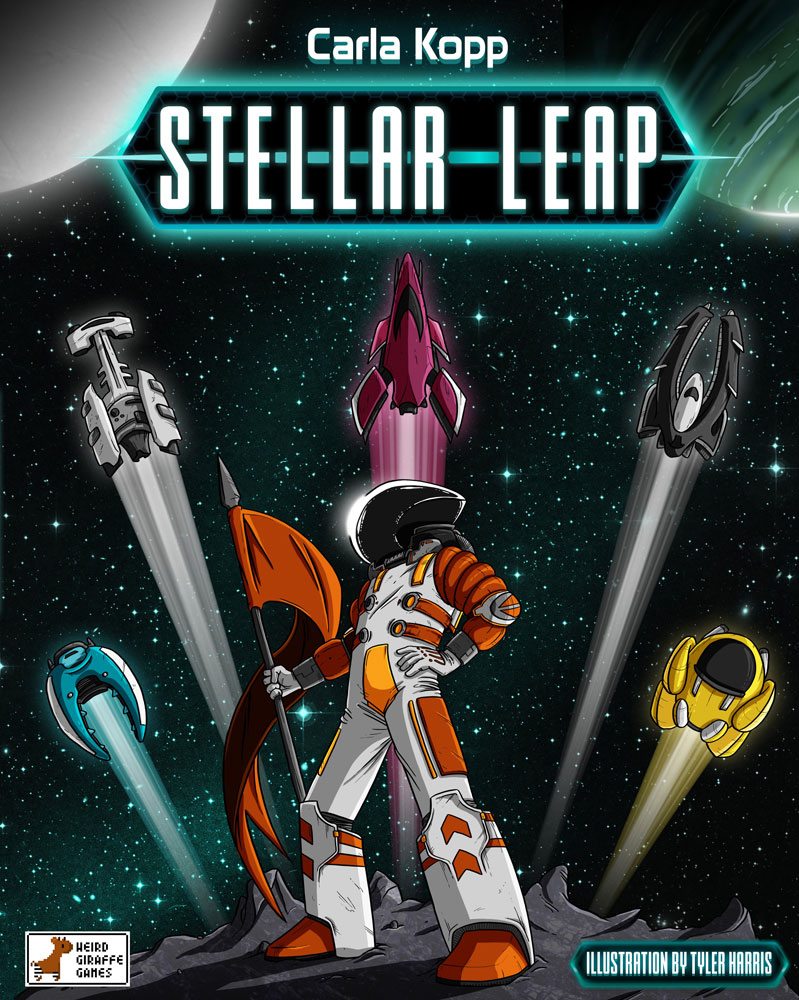Your civilization has finally achieved spaceflight, and you’re ready to explore the stars! Of course, you’re not alone. Explore the vast reaches of space, mine asteroids, and colonize planets. Who’s ready to make the Stellar Leap?
What Is Stellar Leap?
Stellar Leap is a space exploration game for 1 to 4 players, ages 14 and up, and takes about 20 minutes per player. It’s currently on Kickstarter, with a pledge level of $39 for a copy of the game (or $49 for the game with expansion). The game does not have anything inappropriate for younger players, and I think perhaps experienced gamers as young as 10 would be able to enjoy it as well.
New to Kickstarter? Check out our crowdfunding primer, and visit our Kickstarter curated page for more projects we love.

Stellar Leap Components
Note: My review was based on a prototype, so final artwork and component quality may be different. One notable difference is that the mission cards in the prototype are half-sized cards, but will be full-sized cards in the final version. Be sure to visit the Kickstarter page for the most updated information.
- 28 Planet cards (14 Safe, 14 Dangerous)
- 34 Mission cards (11 Tier 1, 11 Tier 2, 12 Tier 3)
- 6 Dice cards
- 12 Event cards
- 4 Home Planet cards
- 11 Dice Power cards (3 Universal, 8 Species)
- 8 Trait cards
- 4 player boards
- 2 large dice
- 3 small dice
- 40 meeples (10 in each player color)
- 48 player tokens (12 per player color)
- 16 resource cubes (4 per player)
- 20 Action Tracker cubes (4 per player)
- 4 Reference cards
- 3 Solo AI cards

The player board is fairly easy to use: four resource tracks show how much fuel, water, food, and oxygen you have. At the bottom is your population track, where you put your meeples. As you place your population onto planets, you can easily look at your board to see how many you’ve placed, without having to look around the galaxy and count them. Your available actions are also marked in the center of the board, with some cubes to track which actions you’ve taken this turn.

The four player boards each have a character portrait (and an associated icon, which appears on the player tokens). I really like the different alien races—there’s some sort of bug, a bird, a mammoth, and a dinosaur. I also like that the player colors are ones that should be easy to tell apart for color blind players: black, yellow, purple, and blue. The only caveat is that I found the black meeples hard to see on the black space backgrounds of the planet cards; I’ve been told that those may be changed to a different color instead.

The planet cards have names like Caution and Perplexity and Remorse, along with various spaces showing what resources they generate, and a threat level that will influence how much fuel it costs to travel there. The safe planets all have 1 threat level, and the dangerous planets may be 2 or 3 threat level. Each card has a “ready” space, an “exhausted” space, and a small place to put the player token to mark who discovered the planet. The resource icons are a little small, though, so hopefully in the final version they will be a little easier to read from across the table.

I do know that the card backs (which currently just feature the Stellar Leap logo and the card type) will be a little more exciting in the finished version. The fronts of some of the cards (like the event cards) are currently a little boring—just text on a black background with some borders—so I hope those will get a visual upgrade as well.

How to Play Stellar Leap
You can download a draft of the rulebook here, as well as a black and white Print and Play (without graphics).
The Goal
The object of the game is to score the most points by fulfilling missions, increasing your population, discovering planets, and meeting requirements for your secret trait.

Setup
Give each player a player board and the matching meeples, action tracker cubes, and tokens, plus 4 resources cubes. The meeples should be lined up along the bottom of the board on the population track. The resource cubes are placed on the resource tracks, marking 3 of each resource. The action tracker cubes are placed on the action track. Each player is dealt 2 trait cards and 2 player dice power cards and chooses one of each to keep and discards the others face-down. The traits are kept secret, and the player dice powers are revealed.

Set out the six dice cards in a horizontal row. Draw one universal dice power at random and place it face-up nearby. Shuffle the various decks separately and place them nearby: Safe Planets, Dangerous Planets, and Events. Form mission decks: for Tier 1 and Tier 2, use 2 cards per player, and use all of the Tier 3 cards. Shuffle each tier separately, and then reveal four Tier 1 missions.
Each player in turn order will place their home planet into the galaxy, and then place one token on it and one meeple on it. The galaxy consists of rows of cards below the dice cards. Whenever a card is placed into the galaxy, you may place it in any column, but it must be in the closest empty space to the dice cards in that column.

Turn Order
On your turn, you do the following:
- Recover exhausted population: any exhausted population is moved to the “ready” side of the planet cards.
- Roll two dice.
- Use a dice power: You may use either your own player dice power or the universal dice power to manipulate the dice if desired.
- Generate resources: Every planet in a column that matches the die values rolled or the sum of the two dice now generates resources. If you have at least one “ready” meeple on that planet, you gain the resources listed on the planet. Note: if the planet is overpopulated (at least 1 population per player, or from at least 3 players in a 4-player game), then you get resources based on the “overpopulated” section of the card instead. If both dice are the same value, you may generate twice as many resources.
- Move populations and use your actions: More on this below.
During your turn, you may move populations around—this can be done as many times as you can afford it, and does not require an action. You may move any number of population (meeples) from one card to another card. Spend 1 oxygen per population. Then spend fuel equal to the threat level of the destination (safe cards have a threat level of 1, and dangerous cards have a threat level of 2 or 3). Finally, spend 1 fuel per solar system traveled. Each horizontal row of cards counts as a solar system, so if you stay within the same solar system you don’t spend any extra fuel. If you moved two rows away (into any column in that row), you would spend 2 fuel for the solar system travel. (Note: You may never travel to another player’s home planet.)

You have five available actions each turn, though you might not use all of them. As you use actions, you can mark them with your action cubes on your board to help keep track. You have two available High Command actions, which may be spent on a few different options, and you have three specific Division actions.
High Command actions are listed here. You may take the same action twice.
- Populate: Spend 2 food and 1 water to add a population from your board onto the ready side of any planet where you already have population.
- Tax: Gain two resources of your choice.
- Discover: Draw two cards from a planet deck. Choose one and return the other to the bottom of the deck. Place the card into the galaxy (in any column, and then in the closest empty row in that column) and then place one of your player tokens on it to mark that you discovered it. If the card is an asteroid, place one of the small dice on it set at value 3.
- Attack: If you have more population on a planet than the total of all other players, you may attack. The other players each give you one of their player tokens (placed on your board to indicate a successful attack) and then their populations on that planet must flee to another planet in the same solar system. If there are none available, they retreat to a planet in the nearest solar system. The populations that fled are now exhausted.

There are three Divisions, each with its own action. You may only take one of each of these actions.
- Intelligence Division: Complete one mission by spending the necessary resources. You will get resources as a reward, and then take the mission card, which is worth points at the end of the game. Refill the mission from the lowest available tier.
- Mining Division: Mine an asteroid. You must pay to move to an asteroid, and then use this action to mine it. Roll a number of dice equal to the current value of the asteroid die. You gain resources equal to one of the dice, plus the resources shown on the asteroid card. Then decrease the value of the asteroid die, and return back to your previous planet for free.
- Labor Division: Exhaust one of your population to get resources from that planet, as shown on the card.

Events
There are various things that can trigger an event immediately. If any of these happen during your turn, you draw the next event card:
- A solar system is filled (any row has 6 cards in it).
- All players hit 3, 6, or 9 population. (These events only trigger when all players reach the population thresholds.)
- 3, 6, or 9 asteroids have been placed.
- A tier of missions has been completed.
- A planet deck is depleted.
Read the event card and do what it says. Some events are good, and some are bad.
Game End
After the 6th event has occurred, finish the round so that all players have had the same number of turns. (You may continue to trigger new events.)

At the end of the game, you score points based on the number of discoveries you have (planets and asteroids you’ve placed), population that you have created, successful attacks, and completed missions. You also reveal your trait cards and score points based on it. The highest score wins! (There is no tie-breaker rule.)
Variants
For a shorter or longer game, you can vary the number of events required to trigger the game end.
There’s a 5th-player variant (there will be another set of player components as a stretch goal), which plays almost the same as the regular game except that there’s an “exhausted player” token used. The player to the right of the active player is the exhausted player, and does not generate any resources on that turn.
There is also a solo variant, which is like a 2-player game with an AI player. You will pick an AI card to use. On the AI player’s turn, you roll two dice and generate resources. The AI player will always mine if possible, and will perform High Command actions based on its card. If you attack the AI, it will scatter to as many different planets as possible. Each AI card has its own scoring system.

Why You Should Play Stellar Leap
I’ve written recently about a couple of games that are 4X-style games but are different from the huge multi-hour titles like Eclipse or Twilight Imperium, and it’s fun to see how people are approaching the space-exploration game in a more compact form. I would personally describe Stellar Leap as a 3X game: it has exploration, exploitation, and extermination, but not necessarily expansion. (Or maybe it’s expansion but not exploitation.) Basically, you can discover new planets and asteroids, and you spread out your population to harvest more resources, and you can attack people. But there isn’t a tech tree where you build up new abilities or powers.
The resource generation mechanic in Stellar Leap reminds me of Machi Koro and Valeria: Card Kingdoms: each player rolls the dice on their own turn, but that roll can generate resources for everyone, not just the active player. In this case, though, the active player has the ability to manipulate the dice, which can be very fun (or mean). Depending on where everyone has their population, you may be able to score a lot of resources for yourself while denying them to your opponents. (And, like Machi Koro and Valeria, you sometimes have to make the decision between spreading out your population so you can generate resources no matter what is rolled, or concentrate your population in hopes of a big payout if the right number comes up.) I do like the fact that the dice manipulation makes it not entirely luck-based, and that you feel like you have a little more control over the results, at least on your turn.
As with most 4X-style games, there are a few different sources of points, and you have to decide what to go after. You won’t get far without at least some population, because you’ll need to spread them out to get resources. In this game, attacking another player doesn’t get you resources directly, but it earns you points. In the case where a planet was overpopulated and everyone was getting fewer resources, it does help you get more resources there. Discovering planets and asteroids also gives you points, but only up to a certain point.
A lot of points will come from completing missions and fulfilling your secret trait card, so it’s important to get a good handle on what resources you have that you can spend on missions. That may mean flying to planets that other players have discovered, or discovering some on your own.

I like the way that the galaxy fills out—you can keep adding cards to a column even if the previous row wasn’t filled yet, but it will cost more fuel to go there. On the other hand, if you start there and add population, you’ll be well positioned to explore that solar system as more cards get added to it, without having to spend extra fuel to fly populations from other solar systems.
Overall I found the rules fairly easy to follow, though with a few specific questions about traits that I needed answered. I do think it’s a game that you could play with your older kids and with adults—there’s a good mix of luck and strategy.
If you wish, you can try out the game on Tabletopia before you make your decision. For more information, or to make a pledge, visit the Stellar Leap Kickstarter page!
Click here to see all our tabletop game reviews.
Disclosure: GeekDad received a prototype of this game for review purposes.






